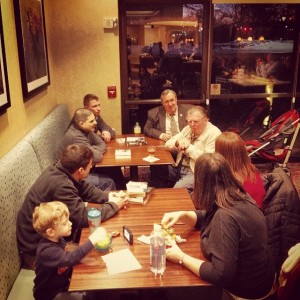Giving a Voice to the Unspeakable: A Chat with Joseph Galloway
By David P. Ervin
It started with a simple question, and it ended with a powerful lesson. Seth Lombardy, a close friend, Soldier, and trademark director asked if I’d like to meet Joseph Galloway. A lot went  through my mind besides the word ‘yes.’ It was an honor. I’d be able to meet a famous author, have my well-worn copy of his book signed, and perhaps pick his brain a little. I didn’t know just how meaningful it would be, though.
through my mind besides the word ‘yes.’ It was an honor. I’d be able to meet a famous author, have my well-worn copy of his book signed, and perhaps pick his brain a little. I didn’t know just how meaningful it would be, though.
When he walked into the hotel lobby just outside of the Pentagon to meet us, you wouldn’t know by looking at him that he’d seen as much history as he had. He was amiable and down to Earth. His demeanor was that of a kindly grandfather. He was humble. Considering he’d interviewed Colin Powell that day, I was humbled. I was a little tongue tied as well, but it didn’t matter much. We let him lead the conversation. Young soldiers know when to listen.
That conversation had a wide range. He discussed the evolution of technology in regards to war reporting. Things have come a long way since waiting on a military phone in Saigon to call in a five-hundred word story. He went on to cover the Gulf in 1991, then the Iraq invasion in 2003. Despite the advances, he thought that something was missing from modern war reporting. He pointed out that everyone could recall an image or set of images from Vietnam, but that there weren’t any memorable photos from the Iraq War. The public got the sugar-coated shots like tearing down Saddam’s statue in Baghdad or a medic cradling a hurt Iraqi child. No images of dead or wounded Americans ever made it to a newscast, and for this reason, it didn’t impact our society as much. But as the conversation continued, it dawned on me that he knew a way around that. We can still record it.
It took Mr. Galloway and LTG Hal Moore ten years to research and write We Were Soldiers Once. He spoke of cold-calling veterans of that battle and of a painstaking process of letting them edit the notes from their interviews. One story connected to that book and battle in particular illustrated the point of it all; why we write, why we share, and why we remember.
He told us the story of CPT George Forrest at LZ Albany. Summoned to the head of a battalion column for a conference, when the NVA opened up a murderous ambush, he had to sprint four-hundred yards through withering fire to link up with his company. The two radio operators with him were killed, but he made it. He put his men into a tight perimeter and saved as many of them as he could given the circumstances. When asked how he felt about it, he harbored some guilt. He didn’t feel he’d done enough, that he could have saved more of his soldiers. So Mr. Galloway wrote the chapter, and like he always did, sent it to the appropriate veterans for their review. CPT George Forrest’s father got to read it. His reaction?
“You done good, son.”
It was a powerful moment, and I’m not sure if there was a dry eye amongst us. Beyond the emotion, though, was a poignant reminder of the importance of recording these experiences. We can give a voice to the unspeakable. We can inform generations about what it was like. We can help them understand, and we can understand better ourselves. Mr. Galloway has been a bridge between military and civilian cultures for nearly half a century. It’s up to us to continue the mission.

